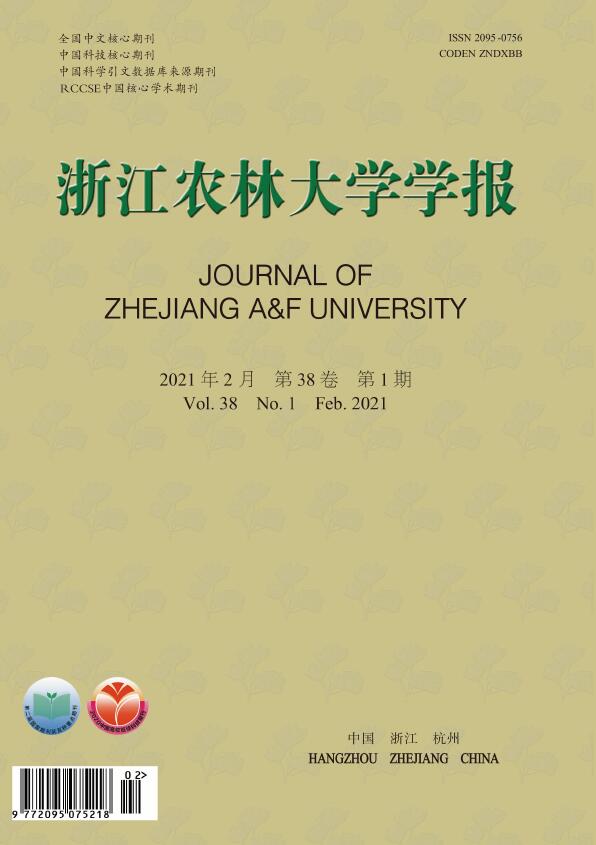-
毛竹Phyllostachys edulis为禾本科Gramineae竹亚科Bambusoideae刚竹属Phyllostachys竹种,用途广泛,是一种可持续发展的重要资源。培育毛竹壮苗是提高实际造林成活率的重要前提[1]。目前,毛竹实生苗因成本低、便于引种等优势,已在生产上广泛利用。油菜素内酯(brassinosteroid,BR)是一种类似于动物甾醇类激素的天然产物,在极低浓度下就可以对植物的生长及发育起到显著的调节改善作用,被认为是继生长素、赤霉素、细胞分裂素、脱落酸、乙烯之后的第六大植物生长调节剂。MITCHELL等[2]首次从油菜Brassica napus花粉中提取油菜素内酯, 发现其极高的生物活性, 能引起菜豆Phaseolus vulgaris节间伸长、弯曲、裂开等生长反应。进一步的研究发现:油菜素内酯参与多种植物生理生长的过程,对植物的生长发育、光合特性、抗逆性、细胞发育和果实品质及产量等方面有重要的调节功能[3-5]。目前,关于外源油菜素内酯对毛竹生理特性影响鲜有报道。本研究以毛竹实生苗为材料,喷施不同质量浓度的油菜素内酯溶液,研究外源油菜素内酯对毛竹实生苗生理特性的影响,以期为培育毛竹壮苗提供理论依据。
HTML
-
选取广西壮族自治区桂林市灵川县境内开花后的毛竹种子。试验地位于浙江省杭州市临安区浙江农林大学智能实验楼温室大棚(30°23′N,119°72′E),年均白昼气温/夜间气温为(23.0±2.0) ℃/(17.0±2.0) ℃,相对湿度为45%~70%。浸种24 h后置于恒温培养箱中的塑料培养盒内等其露白发芽至芽长度超过种子长度后,选取长势一致的种子移至加有1/2强度的Yoshida营养液中培养[6]。待苗长至三叶期后开始叶面喷施0、0.050 0、0.010 0、0.005 0、0.001 0、0.000 5 mg·L−1的油菜素内酯溶液,代号为ck、E1、E2、E3、E4、E5。每处理重复30株,隔15 d处理1次。喷施均以植株叶片上下表面滴水为标准。于2018年3月初开始处理持续至8月底,于9月初采样测定各处理下毛竹实生苗各项生理生化指标。
-
在上午8:30−11:30进行测定,每个处理选取长势一致的毛竹实生苗,测定植株上部第3片的光合指标,单片叶子重复6次取平均值。仪器采用LI-COR 6800光合仪,测定时仪器的相对湿度为60%,二氧化碳摩尔分数为400 µmol·mol−1,光强设定为800 µmol·m−2·s−1。测定指标包括净光合速率、气孔导度、胞间二氧化碳摩尔分数和蒸腾速率。
-
于9月10日测定光合参数后,选取各处理长势一致的毛竹实生苗各8株,将苗拉直后量取顶部至基部的长度,即为株高;用吸水纸擦干根部营养液,拉直后量取整株实生苗根系长度,即为根长;将测完株高和根长的毛竹实生苗快速洗净擦干后,沿基部把毛竹实生苗地上与地下部分切开,放入105 ℃烘箱中杀青30 min,后将烘箱温度调整至70 ℃,将样品烘干至恒量,测定其地上与地下部分干质量。同期选取各处理长势一致的毛竹实生苗叶片各3片,取植株上部第3片叶,参考叶形纸称重法测定叶面积。
-
于9月10日选取各处理长势一致的毛竹实生苗各8株,摘取植株上部第3片叶,采用乙醇提取法测定叶绿素质量分数[7]。同时各处理选取长势一致的毛竹实生苗各8株,摘取植株上部第3片叶,洗净并去除叶脉剪碎后,倒入液氮快速研磨成粉末状,放入50 mL离心管于−80 ℃环境下保存待测:毛竹实生苗叶片过氧化氢酶(CAT)采用紫外分光光度法进行测定[8];过氧化物酶(POD)采用愈创木酚法进行测定[9];超氧化物岐化酶(SOD)采用南京建成生物工程研究所的试剂盒进行测定,可溶性蛋白质质量分数参考考马斯亮蓝法测定,可溶性糖和淀粉质量分数参考蒽酮比色法[10-11]。上述测定指标均重复3次以上。
-
采用Excel进行数据处理及图表绘制。运用SPSS软件中单因素方差分析法对处理间的数据做单因素方差分析、多重比较及差异显著性分析。
1.1. 材料
1.2. 测定分析方法
1.2.1. 植株光合参数测定
1.2.2. 植株生物量测定
1.2.3. 植株生理指标测定
1.3. 数据处理及分析
-
由表1可知:随油菜素内酯质量浓度降低,毛竹实生苗株高、根长和叶面积均呈现先上升后下降的趋势。当油菜素内酯质量浓度在0.001 0 mg·L−1时毛竹实生苗株高达最高(P<0.05),较ck提高了11.0%,0.005 0 mg·L−1处理较ck提高了9.2%。0.001 0 mg·L−1处理较ck,其根长增加了13.4%,0.005 0和0.000 5 mg·L−1处理根长也均高于ck,但低于0.001 0 mg·L−1处理。除0.050 0 mg·L−1处理外,其余4组处理较ck均能显著增加毛竹实生苗叶面积(P<0.05),其中0.005 0 mg·L−1处理较ck效果最为显著;通过叶面喷施油菜素内酯,各处理与ck相比,0.010 0、0.005 0和0.001 0 mg·L−13种处理能显著增加毛竹实生苗全株总干质量(P<0.05),其中以0.005 0和0.001 0 mg·L−1处理为最佳,分别比 ck 增加了25.3%和26.8%。植株地上与地下部分干质量均随油菜素内酯质量浓度降低呈先上升后下降的趋势,且相较ck均有不同程度提升,其中0.005 0 mg·L−1较ck对植株地上部分干质量增加尤为显著(P<0.05),0.001 0 mg·L−1处理较ck对植株地下部分干质量提升尤为显著(P<0.05)。外源油菜素内酯处理各组与ck相比,均能在不同程度上降低毛竹实生苗的根冠比,说明毛竹实生苗地上部分营养生长较旺盛,生物量大。
处理 株高/cm 根长/cm 叶面积/cm2 总干质量/g 地上部分干质量/g 地下部分干质量/g 根冠比 ck 27.69±1.39 c 29.83±0.85 c 11.58±0.22 c 1.38±0.09 c 0.91±0.09 c 0.47±0.03 b 0.52±0.07 a E1 29.93±1.78 ab 29.07±1.22 c 11.98±0.30 bc 1.50±0.12 bc 1.03±0.11 bc 0.48±0.04 b 0.47±0.06 ab E2 30.19±1.48 ab 29.81±0.74 c 13.39±0.57 a 1.71±0.21 a 1.20±0.19 ab 0.51±0.03 ab 0.43±0.05 b E3 30.24±1.95 ab 30.21±1.13 bc 13.68±0.27 a 1.73±0.15 a 1.22±0.15 a 0.50±0.05 ab 0.42±0.08 b E4 30.60±1.88 a 33.84±1.20 a 13.32±0.71 a 1.74±0.20 a 1.21±0.18 ab 0.54±0.04 a 0.45±0.07 ab E5 28.51±1.45 bc 31.10±1.24 b 12.88±0.42 ab 1.64±0.18 ab 1.11±0.19 ab 0.52±0.03 a 0.49±0.11 ab 说明:同列比较,不同字母表示处理间差异显著(P<0.05), 相同字母表示处理间差异不显著(P>0.05) Table 1. Effect of different concentration BR on growth index of Ph. edulis seedlings
-
由表2可知:各处理与ck相比均能显著增加毛竹实生苗叶绿素a的质量分数,但以0.005 0 mg·L−1处理叶绿素a质量分数增幅最大,比ck高11.6%。除0.010 0 mg·L−1处理叶绿素b质量分数差异不显著外,其余处理较ck均差异显著(P<0.05),但0.005 0和0.001 0 mg·L−1处理质量分数高于其他处理。5种质量浓度油菜素内酯处理间总叶绿素和类胡萝卜素质量分数差异均不显著,但相较于ck,差异均达到显著水平(P<0.05)。当质量浓度为0.005 0 mg·L−1时,总叶绿素质量分数高于其他处理,其次是0.001 0 mg·L−1;而0.001 0 mg·L−1处理下类胡萝卜素质量分数高于其他处理。由此表明:外源油菜素内酯处理可以提高毛竹实生苗光合色素水平,增强植株的光能利用率,从而提高植株光合能力。
处理 叶绿素a/(mg·g−1) 叶绿素b/(mg·g−1) 总叶绿素/(mg·g−1) 类胡萝卜素/(mg·g−1) ck 2.28±0.08 c 0.88±0.04 b 3.17±0.12 b 0.92±0.04 b E1 2.50±0.08 ab 1.01±0.06 a 3.51±0.14 a 1.06±0.04 a E2 2.41±0.11 b 0.96±0.08 ab 3.37±0.19 a 1.01±0.06 a E3 2.55±0.08 a 1.03±0.06 a 3.58±0.14 a 1.05±0.07 a E4 2.50±0.10 ab 1.03±0.07 a 3.53±0.17 a 1.07±0.05 a E5 2.50±0.08 ab 1.00±0.06 a 3.51±0.14 a 1.06±0.04 a 说明:同列比较,不同字母表示处理间差异显著(P<0.05),相同字母表示处理间差异不显著(P>0.05) Table 2. Effect of different concentration BR on photosynthetic pigment content of Ph. edulis seedlings
由表3可知:随着油菜素内酯质量浓度的降低,净光合速率、气孔导度、胞间二氧化碳摩尔分数和蒸腾速率均呈现先升高后降低的趋势。相较于其他处理,0.005 0和0.001 0 mg·L−1处理对净光合速率、气孔导度、胞间二氧化碳摩尔分数和蒸腾速率的影响较ck差异最为显著(P<0.05):0.005 0 mg·L−1处理分别提升26.7%、59.9%、14.1%和28.9%;0.001 0 mg·L−1处理分别提升22.7%、50.8%、16.1%和21.9%。说明外源油菜素内酯对毛竹实生苗光合能力具有促进作用,且随着油菜素内酯质量浓度的改变促进的效果发生变化。
处理 净光合速率/(µmol·m−2·s−1) 气孔导度/(mol·m−2·s−1) 胞间二氧化碳摩尔分数/(µmol·mol−1) 蒸腾速率/(mmol·m−2·s−1) ck 6.87±0.21 c 0.051±0.005 d 211.47±15.86 c 1.36±0.08 c E1 7.07±0.21 c 0.069±0.005 c 231.57±13.77 ab 1.48±0.13 bc E2 7.53±0.32 b 0.074±0.005 bc 223.91±17.69 bc 1.56±0.16 b E3 8.70±0.33 a 0.082±0.004 a 241.37±10.34 ab 1.75±0.08 a E4 8.42±0.33 a 0.077±0.003 ab 245.53±9.62 a 1.66±0.13 ab E5 7.49±0.41 b 0.074±0.006 bc 234.66±11.15 ab 1.59±0.15 ab 说明:同列比较,不同字母表示处理间差异显著(P<0.05),相同字母表示处理间差异不显著(P>0.05) Table 3. Effect of different concentration BR on photosynthetic parameters of Ph. edulis seedlings
-
由表4可知:相较于ck,其他4种质量浓度处理的毛竹实生苗叶片的可溶性蛋白质质量分数均达到差异显著水平(P<0.05),随着喷施质量浓度的降低,可溶性蛋白质呈现先上升后下降的趋势,且在0.005 0和0.001 0 mg·L−1处理下达到最大值。叶面喷施条件下,除0.010 0和0.001 0 mg·L−1差异不显著外,其他处理与ck相比可溶性糖质量分数均达到显著水平(P<0.05),其中0.050 0与0.000 5 mg·L−1处理之间差异不显著,而0.005 0 mg·L−1处理后较ck增幅最大(P<0.05),增加了10.9%。随着油菜素内酯质量浓度的降低,毛竹实生苗淀粉质量分数也呈先上升后下降的趋势,0.005 0和0.001 0 mg·L−1处理较ck差异达显著水平(P<0.05),分别增加17.3%和16.9%。说明外源油菜素内酯溶液可以调节毛竹实生苗体内渗透调节物质的质量分数,有利于植株正常生长发育。
处理 可溶性蛋白质/(mg·g−1) 可溶性糖/(mg·g−1) 淀粉/(mg·g−1) 处理 可溶性蛋白质/(mg·g−1) 可溶性糖/(mg·g−1) 淀粉/(mg·g−1) ck 4.02±0.20 d 5.08±0.11 c 1.37±0.03 c E3 5.29±0.14 a 5.64±0.15 a 1.61±0.06 a E1 4.21±0.06 c 5.32±0.13 b 1.52±0.08 a E4 5.28±0.13 ab 5.17±0.20 bc 1.60±0.07 a E2 4.26±0.06 c 5.04±0.20 c 1.51±0.02 ab E5 5.10±0.08 ab 5.35±0.20 b 1.42±0.02 b 说明:同列比较,不同字母表示处理间差异显著(P<0.05),相同字母表示处理间差异不显著(P>0.05) Table 4. Effect of different concentration BR on soluble protein,soluble sugar and amylum content of Ph. edulis seedlings
-
由表5可知:超氧化物歧化酶和过氧化氢酶活性随油菜素内酯质量浓度降低呈现先上升后下降的趋势。当质量浓度在0.001 0~0.005 0 mg·L−1时,植株超氧化物歧化酶活性达到最大值,其中0.005 0 mg·L−1处理相较于ck增幅最大,提高了6.7%;过氧化氢酶活性则在0.005 0和0.001 0 mg·L−1处理下达到最大值。毛竹实生苗叶片的过氧化物酶活性,随油菜素内酯质量浓度的降低呈升高趋势,当质量浓度在0.000 5 mg·L−1时,植株过氧化物酶活性相较ck差异达显著水平(P<0.05),依次是0.005 0和0.001 0 mg·L−1。这些结果表明:毛竹实生苗叶片的抗氧化酶活性受外源油菜素内酯质量浓度影响,适宜质量浓度油菜素内酯可以提高抗氧化酶活性,增强植株抗逆性。
组别 超氧化物歧化酶/
(×16.67 nkat·g−1)过氧化物酶/
(×16.67 nkat·g−1)过氧化氢酶/
(×16.67 nkat·g−1)组别 超氧化物歧化酶/
(×16.67 nkat·g−1)过氧化物酶/
(×16.67 nkat·g−1)过氧化氢酶/
(×16.67 nkat·g−1)ck 3 018.58±80.60 bc 43 031.11±2 231.96 c 46.81±1.47 c E3 3 219.58±106.30 a 49 306.67±1 573.26 ab 50.67±0.73 ab E1 2 978.00±102.19 c 46 871.11±1 625.14 b 46.96±2.57 c E4 3 202.99±99.55 a 48 937.78±2 994.76 ab 53.63±2.00 a E2 3 159.32±111.30 ab 46 404.44±1 779.30 b 48.44±0.73 bc E5 3 187.05±118.30 a 51 733.33±2 538.05 a 46.37±0.91 c 说明:同列比较,不同字母表示处理间差异显著(P<0.05),相同字母表示处理间差异不显著(P>0.05) Table 5. Effect of different concentration BR on antioxidant enzyme activities of bamboo seedlings
2.1. 不同质量浓度油菜素内酯处理对毛竹实生苗生长性状的影响
2.2. 不同质量浓度油菜素内酯处理对毛竹实生苗光合特性的影响
2.3. 不同质量浓度油菜素内酯处理对毛竹实生苗可溶性蛋白质、可溶性糖和淀粉质量分数的影响
2.4. 不同质量浓度油菜素内酯处理对毛竹实生苗抗氧化酶活性的影响
-
植物营养生长是指根、茎、叶等营养器官的生长,通过分析植物器官表型可以判断植物的生长情况。油菜素内酯能在植物各个生长发育阶段起到促进生长的作用,能有效提升植物株高、根长及干物质的积累[12]。有研究表明:油菜素内酯对小米Setaria italica[13]、玉米Zea mays[14]、黄瓜Cucumis sativus[15]和甘草Glycyrrhiza uralensis[16]等植物均有促进生长的作用。本研究中,叶面喷施不同质量浓度的油菜素内酯,能不同程度地影响毛竹实生苗的生长发育,其中以0.001 0~0.005 0 mg·L−1质量浓度为最佳。当油菜素内酯质量浓度为0.05 0 0~0.010 0 mg·L−1时,毛竹实生苗地上部分生长虽然没有出现生长抑制的现象,但该质量浓度处理后根系长度有小于对照的趋势,可能的原因是持续高质量浓度的油菜素内酯处理能够调控根系内部乙烯合成,造成根尖顶端优势丧失,进而抑制根系伸长[17]。0.001 0 mg·L−1油菜素内酯对毛竹实生苗根系生长具有促进效果,即较低质量浓度处理能促进毛竹实生苗根系生长,这与邓茜等[18]在小麦Triticum aestivum中的研究结果相似,推测油菜素内酯对根系细胞的伸长或许与生长素类似具有双重效应。生长素浓度高低会分别启动不同的信号传输途径来调节植物生长,即低浓度促进生长,高浓度抑制生长[19-20]。在本研究条件下,适宜质量浓度油菜素内酯处理有效增加了毛竹实生苗的株高,促进了叶片生长。这与前人在烟草Nicotiana tabacum[21]和狐米草Spartina patens[22]上得到的研究结果相类似,说明植物生长可能与油菜素内酯直接促进细胞生长和分裂的效应有关[23-24]。
植物利用光合作用将光能转化为自身生命活动所需的有机化合物,因此,光合作用的强度能反应植物的生活力[25]。随着油菜素内酯质量浓度降低,毛竹实生苗净光合速率、气孔导度及胞间二氧化碳摩尔分数均呈现先升后降的趋势,且在0.001 0~0.005 0 mg·L−1达到最大值,推断适宜质量浓度油菜素内酯可以通过调节气孔,吸收外界二氧化碳向羧化部位扩散,从而增强毛竹实生苗光合能力。这与油菜素内酯在高粱Sorghum bicolor[26]和甘蓝型油菜[27]上的研究结果相似。而YU等[28]发现:油菜素内酯处理后黄瓜幼苗气孔导度和蒸腾速率提高,但胞间二氧化碳摩尔分数却无显著变化,认为气孔因素和非气孔因素有可能都是提升黄瓜幼苗光合能力的原因,这与本研究的结果有所不同。王金平等[29]研究发现:油菜素内酯对樟树Cinnamomum camphora叶绿素含量积累和光合能力均有促进作用。郝建军等[30]认为:油菜素内酯处理能提高玉米叶绿素含量,提升光合速率,但油菜素内酯对光合能力的提升并不是直接活化光合系统,可能是通过某种较长时间的生化反应过程来实现的。BRAUN等[31]研究表明:油菜素内酯可以通过提高植物体内叶绿素含量,促进植物进行光合作用。在本研究中,毛竹实生苗叶片的总叶绿素质量分数与净光合速率均在0.001 0~0.005 0 mg·L−1达到最大值,这可能是外源油菜素内酯能影响聚光色素复合体上的蛋白表达或者调节叶绿素合成降解的关键酶来促进光合色素合成[32],提高植物光合固碳效率,促进植物光合作用[33]。该结果与油菜素内酯在樱桃番茄Lycopersicum esculentum var. cerasiforme[34]和油用牡丹‘凤丹’Paeonia ostii ‘Fengdan’[35]上的结果相似,但不同物种之间生物学特性存在一定差异,这使得其对不同质量浓度油菜素内酯的敏感程度不同。除对照组外,各组毛竹实生苗之间地上与地下部分干质量差异并不大,但当油菜素内酯质量浓度在0.001 0~0.005 0 mg·L−1时,毛竹实生苗全株干质量较其他处理组有明显的提升。说明随着光合能力的增强,油菜素内酯能促进植株干物质的积累[36],从而促进毛竹实生苗生长发育。
有研究认为:外源油菜素内酯处理可诱导合成可溶性蛋白质、可溶性糖等渗透调节物质,提高超氧化物歧化酶、过氧化物酶和过氧化氢酶等3种抗氧化酶的活性,从而减轻膜脂过氧化对细胞膜系统的损伤,增强植物的抗逆性[37]。总体而言,在0.001 0~0.005 0 mg·L−1的油菜素内酯处理下,抗氧化酶活性和渗透调节物质质量分数均保持在较高水平,说明喷施适宜质量浓度的油菜素内酯,可能促进植物体内抗氧化酶的合成或调解相关基因的转录与翻译,进而激活抗氧化系统[38],调节相关代谢酶水平,维持植物体正常生理代谢,抑制膜脂过氧化,保持植株细胞膜正常结构,同时维持细胞渗透平衡,增强细胞的保水功能[39]。这一结果与前人在水稻Oryza sativa[40]、番茄Solanum lycopersicum[41]、裸燕麦Avena nuda[42]上的研究结果相似。植株抗氧化水平的提高,可为生长提供有利条件,利于毛竹实生苗营养生长。本研究结果表明:当质量浓度为0.001 0~0.005 0 mg·L−1时, 油菜素内酯持续处理能够促进毛竹实生苗体内渗透调节物质合成,提高抗氧化酶活性,增强实生苗抗逆境能力;还能显著提升植株光合色素质量分数,提高其光合能力,促进干物质的积累,增加生物量,达到促进毛竹实生苗营养生长的效果。









 DownLoad:
DownLoad: